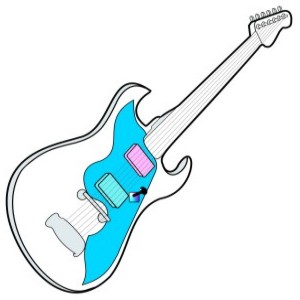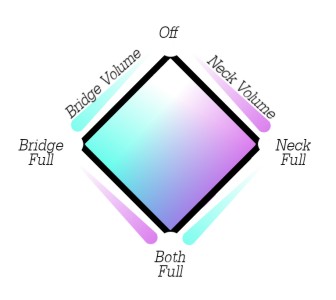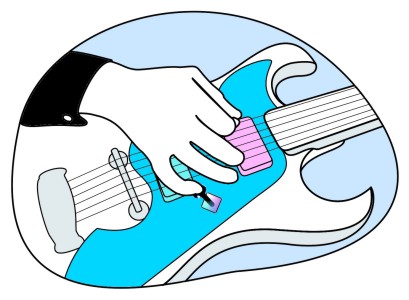|
|
A Volector is a convenient simultaneous dual signal level control.
The volector circuit has a single joystick that controls two pickup signals' levels at once, and thus serves as both a master Volume control and a pickup balance Selector. It replaces twin volume knobs.
Most popular control circuits for two-pickup guitars provide only partial functionality; the initial design was never changed.
A volector joystick is preferably mounted on the body of your guitar, just below the commonly picked section of the strings between the neck and bridge pickups.
|

|
In that location, a volector can be used while picking, with striking results. The control pattern is simple: tilt the joystick handle forward along the strings toward the neck pickup to fully select the neck pickup signal. Tilt it back toward the bridge pickup to select the bridge pickup signal. Tilt the handle up, toward the strings, to mute/suppress the sound. Tilt the handle down, away from the strings, for full volume from both pickups. Intermediate positions produce intermediate signal mixes, as you would expect.
|
Because the two pickup signals have different sounds, this easy, smooth panning selection enables a tremendous range of expressive phrasing.
Two signals define a spectrum
A two-channel guitar, rigged with a different effect on each pickup's signal, provides the complete spectrum of intermediate tones through the volector's precise control.
If a distortion box is connected only to the bridge pickup's output signal and not to the neck pickup's signal, tilting the stick toward the unprocessed neck pickup produces a cleaner total sound. Distortion increases as the joystick moves toward the bridge.
|

|
Volector provides a better way to control blend and total volume
A volector significantly reduces a player's need to stop picking to adjust signal volume. The joystick's linear action is easier to use than twin rotary knobs. It's also easy to see and feel where the control is currently set. The joystick can be nudged and left at a desired setting, or the picking hand can move along the strings while playing, casually escorting the stick.
A volector gives practical independent control of two signal volumes by one movement. The player's picking hand can, while picking, accomplish exact, immediate level control of both pickup signals, and rapid panning between them. It's like being able to use two pedals without having to stop dancing.
Dynamic blending plus polarity switching... gives surprising new sounds
The volector circuit joystick is a convenient way to make pickup balance adjustments that most guitars cannot make. (Here's another link to why most popular control circuits for two-pickup guitars provide only partial functionality.) ...The Volector goes significantly beyond fixing that problem...
The volector circuit also includes a toggle switch to reverse the polarity on one of the pickups - it can put the pickups "out of phase" - and now your guitar can make new sounds. Here's the tech of it:
A guitar pickup senses movement of its string across the pickup's location. Since harmonics of the string are standing waves, for every note there are unmoving nodes (wave motion pivot points) at sites that are even divisions of the vibrating part of the string. If a pickup happens to be located just under a node, the note will only be sensed very faintly. If the pickup is located halfway between nodes, the note will be sensed strongly because the string is moving vigorously there.
Thus, each pickup responds with varying signal strength to notes the string can produce, depending on the pickup's location along the string. The neck and bridge pickups, being in different locations, have different response patterns. When the pickups are used together "in phase", the signals reinforce eachother, and generally the weak note signals of one pickup are filled in by the other pickup. The total signal output of the instrument across frequencies is made more consistent by summing the matched-polarity signals.
When the polarity of one pickup's signal is reversed, if both pickups have a signal of similar magnitude on a frequency, those signals will counter and cancel eachother. This puts gaps in the frequency response of the instrument, creating interesting timbre.
There is an excellent analysis and discussion of this in electric guitars, with graphs of frequency response, at
http://www.till.com/articles/PickupMixing/index.html
On that page, Figure 7 (Various mixes of the neck and bridge pickups, opposite polarity) presents a nice graphic progression of the combined response of varying pickup blends when the signals are of opposite polarity.
In that section Neck and bridge pickups, opposite polarity, J. Donald Tillman states,
...small changes in the balance between the two pickups have very large effects on the timbre of the sound. Because of this effect I will claim that an opposite polarity pickup combination is seriously handicapped without control of the balance between the pickups.
|
...and that's exactly the control the volector circuit gives.
Dynamic variation of the blend of the pickups further modifies the sound, as our ears are as sensitive to how sound is changing, as to what it is at a given moment. This is subtle when the pickups are set to congruent polarity, and can be exciting when opposite polarity is chosen. Ring modulators and phase shifters, wah-wahs, and other effects rely on our interest in changing timbre. The volector joystick gives fine manual control of pickup blend while playing - a reliable method to create and control new timbres, new effects.
|
|
An abstract of the volector circuit's U.S. patent 7,304,232 can be seen here. The circuit diagram is available in documentation available on the Build a volector page.
|
|
From the musician's point of view - How to Use It
Setup
A "Volectar" (a guitar with a volector control circuit) provides its output as two separate signals, one from each pickup. It is intended to be used with a cable that terminates in two jacks. Such cables are sometimes called stereo guitar cables. You will get a suitable cable with your guitar if you buy from us, and they are available elsewhere as well.
Electrically, the output of the volectar is equivalent to that of two "regular"guitars. If your amp does not have two inputs, the signals must be mixed together.
There are two ways to combine signals properly, that is, without the level control on one affecting the other. A proper passive "Y" will reduce the output levels by about 8dB. An active mixer can maintain or boost output levels, but requires a power source.
Of course, even more fun is playing your guitar through two amps at once.
Another advantage of separate signals is the opportunity to use different effects units on the two signals. Panning between the pickups then can select and blend the effects.
Setup care must be taken if you want to play out-of-phase pickups through external effects. Digital effects units often delay the output by a small interval, and the delay on the two signals must be matched to get the full comb filter effect.
The best choice of effects units, number of amplifiers, and signal merging method depends on what music you are making.
Q: What happens if you use a regular mono guitar cable?
A: If you plug a regular one-jack cable into a volector circuit, you will only hear one of the two pickups' signals. We wire ours so that the bridge pickup's signal is the one you get. The joystick will control that pickup's level as usual.
Basic control
The volector joystick is easy to move to any position within its travel limit. It stays where it's put, so it can be used like traditional controls often are, "set it and forget it."
To set overall volume, think up-soft and down-loud. To choose pickup balance, shift sideways toward a desired pickup, or keep to the middle for both pickups equally.
In its simplest use for occasional changes, a nudge to the stick is all that's needed.
Taking it further
More advanced volector technique includes changing pickup balance while playing a phrase. A riff can start clean, and slide toward a distorted crescendo. Or start with an echo, and resolve to intimate clarity.
Preliminary setup is choosing your desired tones or effects for the two pickups' signals. The natural sounds of pickups in different locations on the guitar's body are normally quite distinct, so the use of effects is not needed to take advantage of the volector's versatility.
The volector is located conveniently close to the picking area of the instrument strings. Once playing begins, the stick can be moved while picking to select from (or slide along) the entire spectrum between one signal's sound and the other.
Below is a picture showing a good picking hand posture for continuous volector control. The pick is held normally between the thumb and first finger. Any free finger's tip may rest gently in the fingertip cup, so that moving the hand forward or back along the strings naturally draws the cup along with it, shifting the balance of the pickups' signals.
|

|
A simple linear movement of the picking hand along the strings takes the stick's end with it. The familiar tone control accomplished by picking near the bridge for a lead riff, or close to the neck for a rhythm phrase, is enhanced as the joystick tilts with the hand's movement to alter the blend of the signals toward the appropriate pickup.
For a swell, moving the cup downward increases overall volume. The bottom point of the joystick's travel square is full volume from both pickups. Conversely, stick straight up toward the strings mutes the output. For tremolo, wiggle the stick up and down.
|
Overall volume = up-soft, down-loud.
Pickup balance = sideways toward a desired pickup, middle is both.
The envelope of notes and phrases can be finely controlled with a volector. Rhythmic circling or patterned movement of the cup while playing can produce interesting results.
Using the polarity switch:
In normal mode ("in phase", switch "0" position) the joystick is used to set any static blend of the two pickups, or for swells, or tremolo.
In reverse mode, since one signal is 180 degrees out of phase, specific lower frequencies cancel when mixed, making the joystick work something like a wah-wah or phase shifter.
Set the switch to the "180" position. Movement of the cup while playing dynamically alters the ratio of signals of opposite polarity. Signal frequency cancellation creates a changing filter that can produce timbres unavailable to any guitar heretofore.
|
|
|
|


